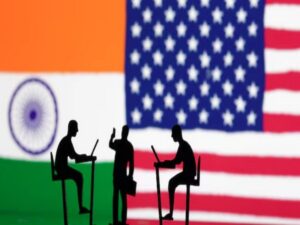AI will change way news is produced and consumed: The Times Group MD Vineet Jain
New Delhi [India], August 27 (ANI): Artificial Intelligence as a technology will change the way news is produced and consumed even as its essence would endure, said Vineet Jain, Managing Director, The Times Group.
Delivering a special address at the exchange4media’s ‘NEWSNEXT’ summit here on Sunday, he also stressed that as the newer realms of broadcasting, digital tech, and AI open up, the challenge would be to uphold ethical standards, put out accurate information so as to maintain credibility and ensure that algorithms remain unbiased, and the content trustworthy.
In his address at the summit, he made it a point to mention that he firmly believed that journalists are the best self-regulators and have been at the forefront of safeguarding the country’s hard-fought media freedoms against external threats.
As chief content architect of The Times Group, Jain mentioned that he has all along been driven by a core belief in democratizing media and making news accessible to younger and mass audiences using cutting-edge tools.
He also pointed out that he has always emphasised prescriptive journalism — whereby news entities not just highlight and report issues, but also offer solutions as well.
Tracing the emergence of news from print to TV to digital to AI — a journey which he has traversed over 35 years, creating and leading media brands in each of these platforms, Jain highlighted the fact that AI is not about replacing tradition, but about amplifying it, he said.
“Imagine a world where news is tailored precisely to your interests, where data transforms into insightful stories. AI fact-checks at lightning speed, guarding the truth. Language barriers crumble, allowing news to seamlessly transcend linguistic diversity, an essential transformation for a country like India with its multitude of languages and cultures,” he added.
He added that AI technology is not only aiding journalists but also transforming content formats. Text and images are morphing into videos, audio, and beyond even as virtual anchors have now made an appearance, he noted.
“Visualize a newsroom where AI-generated visuals enhance storytelling, freeing journalists to delve deeper. Chatbots engage with you directly, answering questions in real time,” Jain said.
In this journey, Jain flagged the contribution of the TV broadcast revolution, which had, over the past two decades, served as a significant reference point in the digital evolution.
From the time when news services published broadly the same content to the same audience on different platforms, he pointed out how the internet had democratised information and transformed everyone into “potential journalists”.
He pointed out that consumers are paying attention to content creators of all kinds who speak to them in a voice that resonates on the platform they use.
“You can see a completely different service on a mobile phone, to the one you see on TV. TV on the go, cord-cutting, and live TV streaming on OTT platforms became the new norms, reshaping our interaction with television,” he added.
Jain stressed that as TV newsstands at the threshold of a new chapter “where innovation is our ally, and truth our guiding star”, adding that the essence of news would endure.
“We adapt, but our purpose remains unaltered: To inform, inspire, and empower,” Jain signed off saying.






